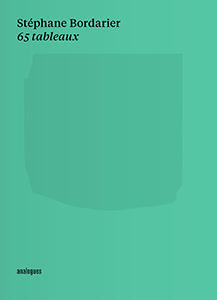The monochrome paintings of Stéphane Bordarier are the result of a research based on the quality of the pictorial surface and the founding role of color. This monograph offers an overview of recent works, followed by two interviews with the artist by
Erik Verhagen.
The time it takes to make a painting is made up of the action of painting plus time spent in contemplation, which accompanies and follows it. I willingly allow myself—and I even actively seek—to be carried away in the momentum of a “series” of paintings: this is the only way that unexpected, non-thought things can enter into it and push it forward. It happens when you get to the point where you no longer know you're in the middle of making a painting, where the act breaks away and, in its relative autonomy, lets things happen. A familiar tune, whose transcendent aspect must not be trusted. Of course, this non-thought must then become thought! In this way it confronts its own era, the history of painting and philosophy, and the work of other artists. The more severe the confrontation, the more the position I have just described in paintings may be perceived for what it is. What is decidedly more interesting again is that it's in the very act of painting-beyond-the-canvas that a part of this contemplation occurs, in a totally unconscious and certainly the sharpest manner, which brings a maximum of things into question.
Stéphane Bordarier, interview with Erik Verhagen
Stéphane Bordarier (born 1953, lives and works in Nîmes) is a French
painter, known for his monochrome paintings. His pictorial approach concentrates on the union of the color with the surface of the canvas, covered with rabbit skin glue.









